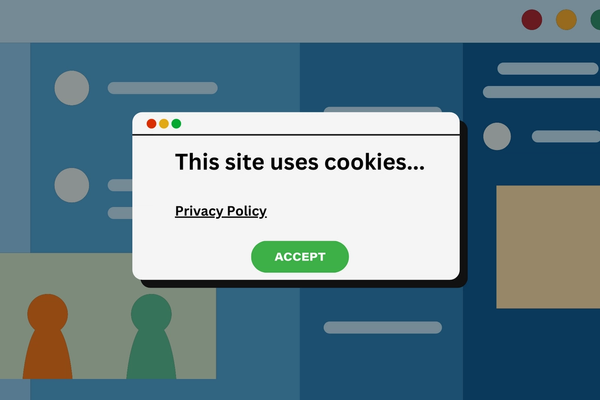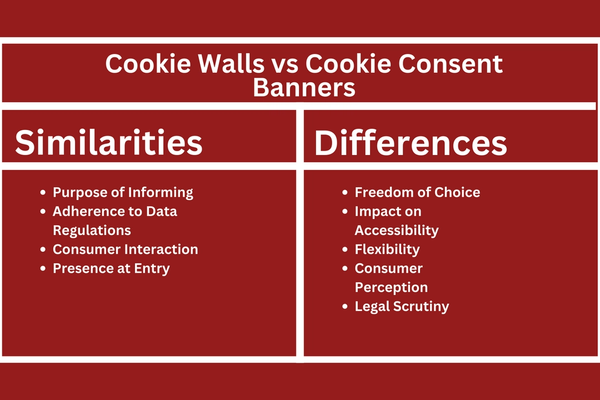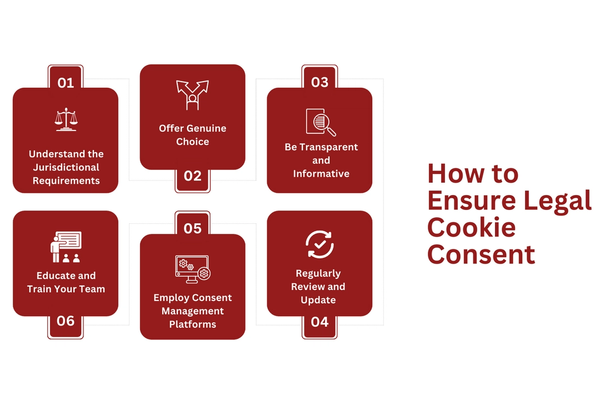
With nearly 2,000 GDPR fines that happen every month, you may be wondering if certain consent practices are allowed for your website. Maybe you’ve heard about cookie walls but don’t know what they are or whether these solutions are legal.
You’re in luck because this article will dive deep into cookie walls, their legality, and their implications for businesses and consumers.
Let’s dive right in.
Key Takeaways
Cookie walls serve as stringent barriers that compel consumers to consent to all types of cookies before accessing content, raising concerns about genuine free consent, especially in jurisdictions like the EU.
Alternatives to cookie walls are cookie consent banners and knowledge walls, offering a balanced approach between business needs and consumer rights, emphasizing transparency and consumer choice.
To ensure legal cookie consent, businesses must understand cookie consent requirements, offer genuine choice, be transparent, and employ tools like Consent Management Platforms.
What is a Cookie Wall?
What is a Cookie Wall.png

At its core, a cookie wall is a digital barrier set up by businesses on their websites. Before a consumer can access the site’s content or services, they must first agree to use cookies, which track and gather their personal data.
This isn’t merely a friendly pop-up – it’s a stringent requirement. If the consumer doesn’t consent, they’re denied entry.
Alana Gibson, COO at DGR Legal, says:
“A cookie wall restricts access to a website unless users consent to cookies. Their legality is debated, as they may conflict with the principle of freely given consent under GDPR.”
This mechanism operates in a way that allows businesses to ensure they have the necessary permissions to collect and process consumer data.
While this might seem like a strategic move to remain compliant with data regulations, it’s a gray area regarding legality.
Many argue that such walls compel consumers to grant consent rather than genuinely offer them a choice. After all, if the only way to access a desired website is by agreeing to its terms, is that genuinely voluntary consent?
Cookie walls cover a broad spectrum of cookies, from strictly necessary cookies required for a website’s functionality to marketing cookies designed to track consumer preferences for targeted advertising. Therefore, it’s not just about essential site operations; it’s about data that can be monetized.
Examples of a Cookie Wall
Examples of a Cookie Wall.png

Imagine visiting a popular news portal. Instead of immediately being greeted with the day’s top stories, you’re met with a full-page notice. This notice informs you that to access any content, you must agree to the use of essential and non-essential cookies.
There are no options to pick and choose which cookies you’re comfortable with – it’s an all-or-nothing scenario.
Another instance might be a video streaming platform. Before you can watch a trailer or even browse the selection of movies, a similar notice appears, demanding cookie consent. Such instances, where the consumer’s experience is halted or conditioned upon agreeing to terms, encapsulate the essence of cookie walls.
The debate over the ethicality and legality of such practices continues, but one thing is clear – as a consumer in the digital age, understanding the tools and tactics businesses employ is crucial.
What are the EDPB Guidelines on Cookie Walls?
The European Data Protection Board (EDPB) has issued guidelines concerning “cookie walls,” which are online mechanisms that restrict access to a website unless the user consents to the use of cookies. The EDPB’s stance on cookie walls is part of their broader effort to ensure that consent under the GDPR (General Data Protection Regulation) is freely given, specific, informed, and unambiguous. Here are some key points:
Definition and Concerns: A cookie wall requires users to accept cookies to access a website, potentially forcing them to choose between their privacy and accessing the service.
Voluntary Consent: The EDPB emphasizes that consent must be a genuine choice. Cookie walls, by their nature, might not allow for such free choice, thus questioning the validity of consent obtained through them.
Transparency and Accessibility: The guidelines suggest that practices like using cookie walls may not fully respect the principles of transparency and accessibility, as they can withhold information or services from users who do not agree to cookies.
What is a cookie widget?
A cookie widget is a tool or plugin used on websites to manage the consent and preferences of users regarding the use of cookies and, by extension, their personal data. These widgets are an integral part of complying with data protection regulations like the GDPR. Key features include:
User Interface: Cookie widgets provide a user-friendly interface that appears on a website, typically when the user first visits, allowing them to choose which types of cookies they consent to.
Customization: They enable users to accept all cookies, reject all, or make specific selections based on categories (e.g., necessary, performance, targeting).
Information: Widgets inform users about the purpose of different cookies, helping them make informed decisions regarding their privacy preferences.
What is the difference between a cookie wall and a cookie banner?
While both cookie walls and cookie banners are mechanisms for managing user consent for cookies, they differ significantly in how they affect user access and choice:
Cookie Wall:
Access Restriction: A cookie wall restricts access to the website unless the user consents to the use of all cookies, making consent a precondition for service.
Choice Limitation: It presents users with an all-or-nothing choice, potentially coercing consent by blocking access to those who refuse cookies.
Cookie Banner:
Access Permissiveness: Unlike cookie walls, cookie banners typically allow access to the website regardless of the user’s choice regarding cookies (with the exception of essential cookies required for website operation).
Informed Consent: Cookie banners offer more flexibility, allowing users to accept all cookies, reject non-essential ones, or customize their preferences, thus supporting the principle of informed consent.
The critical distinction lies in the level of choice and access provided to the user. Cookie banners are designed to inform and obtain consent without conditioning website access on that consent, aligning more closely with the ideals of freely given and informed consent under data protection regulations.
Are Cookie Walls Legal?
Cookie walls have been a subject of intense debate, particularly within the realms of digital rights and data protection. Their widespread use, especially by prominent online platforms, puts them directly in the spotlight. As data privacy concerns grow, many wonder about the legality of such practices.
To truly understand their standing, we must dive deep into various global jurisdictions, each with its own set of regulations and views on the matter.
GDPR (General Data Protection Regulation – Europe)
The GDPR, which governs data protection within the European Union, emphasizes the importance of “free” consent. Given that cookie walls essentially condition access to content upon agreement to cookies, they pose a challenge to this principle.
The European Data Protection Board (EDPB) has hinted that such practices may infringe upon the GDPR’s requirement for consent to be freely given, making their widespread use in Europe questionable.
CNIL (The National Commission on Informatics and Liberty – France)
France’s CNIL, an independent administrative authority protecting data privacy and personal data, has taken a firm stance on the matter.
Following the GDPR’s principles, CNIL announced that forcing consumers to accept cookies to access content is non-compliant. This means that, within French jurisdiction, cookie walls are seen as contrary to the principles of free consent.
LGPD (General Data Protection Law – Brazil)
Brazil’s LGPD is relatively new, coming into effect in 2020, and shares similarities with the GDPR. While the LGPD emphasizes consent, it doesn’t specifically address cookie walls.
However, given its alignment with many GDPR principles, businesses operating in Brazil would be wise to tread cautiously, ensuring consent is both free and informed.
CCPA (California Consumer Privacy Act – USA) & Updated CPRA (California Privacy Rights Act)
The CCPA doesn’t specifically outlaw cookie walls. However, it does grant consumers the right to opt out of data sales. Businesses that deploy cookie walls could potentially face challenges if they restrict or diminish consumer experiences based on these opt-out decisions.
Other Jurisdictions
Across the globe, numerous jurisdictions have yet to provide explicit guidance on cookie walls. Regions like Asia-Pacific and Africa are home to diverse views on data privacy, with individual countries having different laws. In many of these areas, while data protection laws exist, they don’t specifically tackle the topic of cookie walls.
Businesses operating in such regions should remain updated on evolving laws and aim for transparency and genuine consent to ensure trust and compliance.
Not sure what to do in terms of cookie consent on your website? Get in touch today for a complimentary consultation to find out.
Cookie Walls vs Cookie Consent Banners
Cookie Walls vs Cookie Consent Banners.png

When it comes to corporate compliance, knowing the difference between cookie walls and banners is essential.
While both a cookie wall and a cookie banner are mechanisms to address this concern, they differ in their approach, implications, and consumer experience. To discern which one fits where it’s essential to understand their similarities and their distinct characteristics.
Similarities
Purpose of Informing: Both the cookie wall and consent banner aims to inform the consumer about the presence and usage of cookies on a particular website.
Adherence to Data Regulations: Both are tools businesses utilize to maintain some level of data compliance and uphold GDPR and other relevant data protection principles.
Consumer Interaction: Both mechanisms require some form of interaction from the consumer, be it through acknowledgment, agreement, or a choice to proceed.
Presence at Entry: Typically, cookie walls and consent banners are encountered when a consumer first accesses a website, serving as a gateway to the content within.
Differences
Freedom of Choice: A cookie consent banner usually offers a choice. Consumers often decide which cookies to accept and which to decline. In contrast, cookie walls present an ultimatum: accept all or no access.
Impact on Accessibility: Cookie consent banners generally allow consumers to access the content irrespective of their cookie choices, while cookie walls restrict access unless full user consent is provided.
Flexibility: Consent banners are often more flexible, offering options like “learn more,” “customize settings,” or “decline.” Cookie walls, however, are rigid in their requirement for complete consent. This provides a poor user experience.
Consumer Perception: Due to their all-or-nothing nature, cookie walls might be viewed as more aggressive or intrusive, leading to potential friction with consumers. Consent banners, being more lenient, might be perceived as more consumer-friendly and respectful of website visitor privacy choices.
Legal Scrutiny: As discussed earlier, cookie walls face more legal challenges due to concerns about genuine free consent, especially in jurisdictions adhering to GDPR principles. Consent banners, when implemented correctly, tend to align more closely with the principles of informed and voluntary consent.
Alternatives to Cookie Walls
While cookie walls are straightforward, they might not always be the best fit, especially considering the rising legal and ethical concerns.
Fortunately, as technology and data protection principles evolve, a range of alternatives can meet consumer rights needs.
Let’s delve into these alternatives here:
Cookie Consent Banners
A more flexible counterpart to cookie walls, cookie consent banners give consumers information about the cookies a site uses and typically offer choices.
Rather than an all-or-nothing approach, consumers can selectively choose which types of cookies they’re comfortable with.
This respects the consumer’s autonomy and aligns better with data protection principles, allowing businesses to collect essential data without overstepping bounds.
Read more: Cookie Consent Design: How to Design an Effective Banner?
Cookie Consent Manager
Building on the foundation laid by consent banners, cookie consent managers are comprehensive tools that give consumers in-depth control over their personal data.
These managers allow consumers to categorize cookies, dive deeper into their purpose, and make informed decisions.
Additionally, they can be tailored to remember consumer preferences, ensuring a seamless experience during return visits. With the rising demand for data transparency, such tools enhance consumer trust and loyalty.
Knowledge Walls
Moving away from the cookie-centric approach, knowledge walls offer content to the user in exchange for something other than data consent.
For instance, a website (e.g., Washington Post) might provide valuable insights, articles, or resources if a consumer signs up for a newsletter or completes a short survey. This way, businesses can still garner consumer engagement without delving into the murky waters of personal data collection.
Subscription-based Access
In a bid to monetize content without relying on data-driven ads, some platforms are turning to subscription models. By offering ad-free experiences or premium content to subscribers, businesses can generate revenue while sidestepping the complexities of cookie consent.
How to Ensure Legal Cookie Consent
How to Ensure Legal Cookie Consent.png

Cookie consent, seemingly a minor part of business, is actually super important in business.
You must ensure that you obtain valid and legal consent from the user. But how can a business navigate these waters without faltering? Here are some of Captain Compliance’s top tips:
Understand the Jurisdictional Requirements
Before implementing any cookie consent mechanism, businesses should familiarize themselves with the data protection laws of their jurisdiction.
Whether it’s GDPR in Europe, CCPA in California, or any other regional law, understanding the specific user consent requirements is the first step toward compliance.
Offer Genuine Choice
User consent isn’t genuine if the consumer feels cornered. Offering a real choice means allowing consumers to accept or decline cookies, particularly those that aren’t strictly necessary for the website’s operation. This not only aligns with the principle of free consent but also bolsters consumer trust.
Be Transparent and Informative
A consumer can only make an informed decision if they’re provided with clear information. Ensure that your cookie consent mechanism offers concise yet comprehensive information about how cookies function, their purpose, and the kind of personal data they collect.
Simplifying technical jargon and providing straightforward explanations can enhance consumer understanding and cooperation.
Regularly Review and Update Consent Practices
The digital landscape is dynamic, and so are legal frameworks, making it essential for us to consider business solutions and periodically review their cookies policy.
Regularly reviewing and updating cookie consent practices as part of a broader corporate compliance strategy ensures that businesses remain compliant with any new guidelines, cookie consent requirements, or changes in existing laws.
Additionally, it’s good practice to periodically reconfirm consumer consent, particularly if there have been significant changes to the cookie policy.
Employ Consent Management Platforms (CMPs)
As cookie consent becomes more complex, many businesses are turning to Consent Management Platforms (CMPs).
Consent Management Platforms and other compliance solutions not only facilitate the gathering of user consent in alignment with relevant regulations but also maintain records, manage consumer preferences, and ensure that only approved cookies are deployed.
Educate and Train Your Team
Ensuring compliant consent from the data subject (AKA internet user) isn’t solely a technical challenge; it’s an organizational one. Regularly training staff and stakeholders on the importance of data compliance, the nuances of user consent, and the ramifications of non-compliance as part of comprehensive compliance services can foster a culture that values and prioritizes consumer data privacy.
FAQs
Are cookie walls illegal?
The legality of cookie walls depends on the jurisdiction. In some countries, like those within the European Union (EU), they are generally considered illegal under the General Data Protection Regulation (GDPR).
The GDPR mandates that valid consent for data collection must be freely given, and users should not be forced into accepting cookies in order to access a service or website content.
However, other legal systems may have different rules regarding this topic, so it might differ based on your location.
For definitive information specific to certain regions, please consult with Captain Compliance.
Are all types of cookies treated the same under GDPR?
No, GDPR differentiates between essential cookies (necessary for a website’s functionality) and non-essential cookies (like those for marketing or analytics). Only the latter requires explicit consent.
Dive deeper into GDPR’s stance on cookies in our comprehensive guide.
How often should I ask for cookie consent from returning consumers?
While there’s no fixed frequency mandated by most regulations, it’s best practice to ask for renewed consent whenever there are significant changes to your cookie policy or at regular intervals to ensure ongoing consumer awareness.
Learn about best practices for cookie consent in our article here.
Can I use cookies to track consumers without their knowledge if it’s for website analytics?
No, tracking cookies, even for analytics, require informed consent from consumers. It’s essential to maintain transparency about how consumer data will be used.
Discover more about ethical data practices on our dedicated page.
What repercussions can businesses face for not adhering to cookie consent regulations?
Non-compliance can lead to hefty fines, particularly under regulations like the GDPR and CCPA. CCPA fines can go up to $7500 per intentional violation. Additionally, businesses risk eroding trust with their consumers, which can have long-term implications for reputation and consumer loyalty.
Stay updated on the consequences of non-compliance by visiting our latest news section.
How Can Captain Compliance Help You?
As the stakes increase and the rules become more complex, having an ally in your corner can make all the difference.
Captain Compliance is your ally, equipped to guide you through the complexities of cookie consent and overall compliance. Our suite of services, tools, and expertise can empower your business to not only comply but to excel in this new age of digital consent.
If you’re ready to take your cookie consent practices to the next level, reach out to Captain Compliance today for a 100% free consultation so you can find out the next steps toward a compliant future.